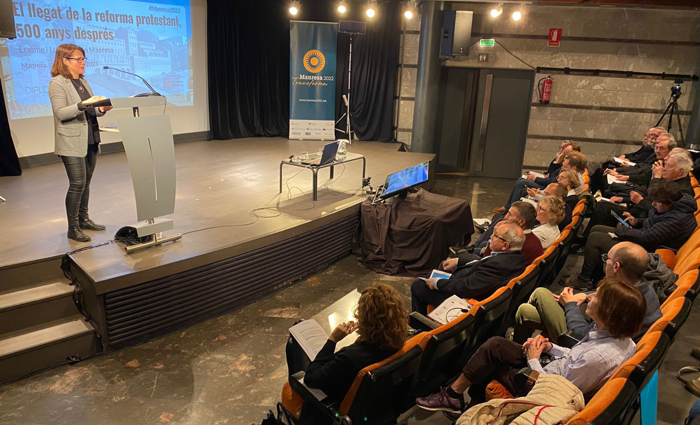DIPLOCAT recalls the legacy of the Protestant Reformation

In collaboration with the City Council of Manresa and as an epilogue to the events celebrating the 500th anniversary of Saint Ignatius of Loyola's stay in the city
Five hundred years ago, in the first half of the sixteenth century, significant trends in humanist, religious and political thought converged, leading to the transformation of Europe. After a period of relative stability, the European project and its values are once again under reflection. In this context, coinciding with the conclusion of Manresa's year of Saint Ignatius, DIPLOCAT proposed an event to reflect on the validity of this legacy with a ceremony that gathered more than a hundred people on 23 March at the Espai Plana de l'Om.
The first to take the stage were the twelve members of the Schola Gregoriana de Catalunya, an ensemble that performed a repertoire of markedly Ignatian Latin songs. The group again returned to perform at the closing of the ceremony. The event, hosted by Miriam Diez Bosch, director of the Blanquerna Observatory of Communication, Religion and Culture (URL), was entitled "The Legacy of the Protestant Reformation, 500 years later". The Institution's opening welcome was given by the Secretary General of DIPLOCAT, Laura Foraster i Lloret, who was very satisfied "to contribute in a small way to the Cruïlla de Caminos interreligious gathering last November and to be able to host this event today, which is like an epilogue of the great roster of activities that have been scheduled to commemorate the 500th anniversary of Saint Ignatius' stay in Manresa".

Antoni Gelonch, the lawyer, writer and patron, gave a talk to focus on the figurehead of Luther. Mr Gelonch spoke of a triple revolution: technological, with the appearance of the printing press; theological, and a revolution involving space and the role of man, in which man becomes the measure of all things and philosophy is freed from theology. Mr Gelonch also offered some explanations as to why Protestantism never truly took root in Catalonia. First and foremost, because the movement never reached Catalan lands, but it was also hindered by the actions of the Court of the Holy See and the will of the monarchy to unite Catholicism with Hispanicity, and by a certain pedagogy of fear.
After that, an international round table was held to compare three models for presenting the figures of the reform to the current public: the Erasmus House in Brussels, represented by its director Zahava Seewald; the Luther Memorial Foundation, based in the German city of Wittenberg, represented by Tobias Espinosa; and the Ignatius of Loyola Cave in Manresa, represented by the founder of the Ignatian Way, Josep Lluís Iriberri. All three agreed on the difficulty educating the new generation on the figures of the past and the importance of an era that is fading away quickly. Ms Seewald spoke of the importance of spaces, which in the case of the house where Erasmus lived in Brussels also includes very attractive gardens. Mr Espinosa explained that they will soon close their museums dedicated to Luther to reform and update them completely. Finally, Mr Iriberri highlighted the validity of the spirituality of St. Ignatius.
The mayor of Manresa, Marc Aloy Guàrdia, closed the event by thanking the attendees, the participants and DIPLOCAT for organising the event, expressing his desire for the city's memory of Saint Ignatius to continue to bear fruit and offer opportunities for dialogue and international cooperation.
